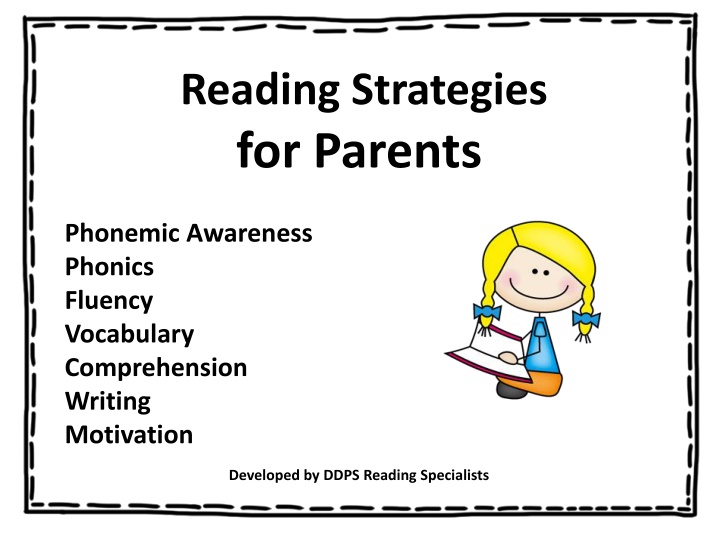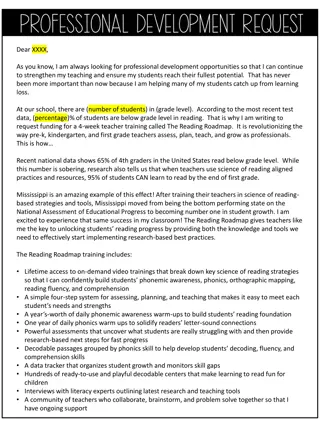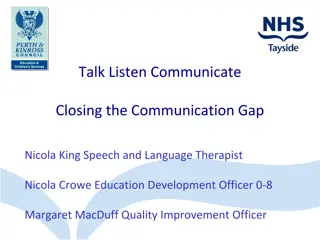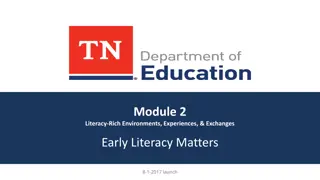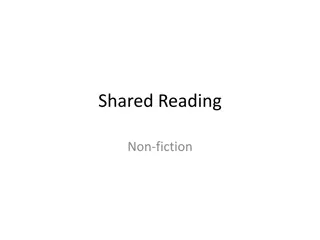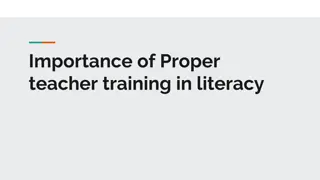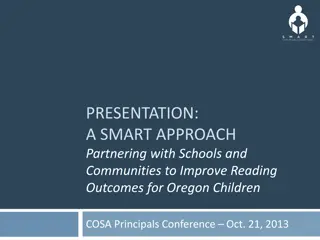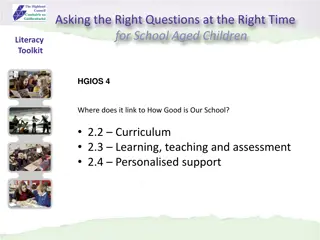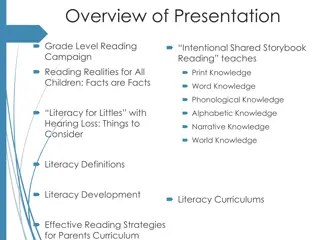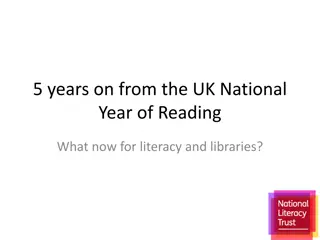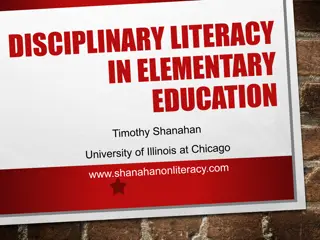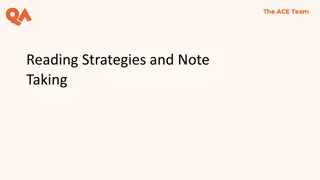Effective Reading Strategies for Parents to Support Children's Literacy Development
Enhance your child's literacy skills with effective reading strategies focusing on phonemic awareness, phonics, fluency, vocabulary, comprehension, and writing. Developed by DDPS Reading Specialists, these strategies help parents engage children in activities that promote learning through phonemic awareness exercises, phonics connections, and building spelling skills using interactive methods. Encourage reading fluency with practices like Rate, Accuracy, and Expression to support overall reading proficiency.
Download Presentation

Please find below an Image/Link to download the presentation.
The content on the website is provided AS IS for your information and personal use only. It may not be sold, licensed, or shared on other websites without obtaining consent from the author.If you encounter any issues during the download, it is possible that the publisher has removed the file from their server.
You are allowed to download the files provided on this website for personal or commercial use, subject to the condition that they are used lawfully. All files are the property of their respective owners.
The content on the website is provided AS IS for your information and personal use only. It may not be sold, licensed, or shared on other websites without obtaining consent from the author.
E N D
Presentation Transcript
Reading Strategies for Parents Phonemic Awareness Phonics Fluency Vocabulary Comprehension Writing Motivation Developed by DDPS Reading Specialists
Phonemic Awareness Think: It can be done in the dark phoneme is a sound. Phonemes make words. Students with phonemic understand that sounds make words. They recognize sound patterns and rhymes. They can move or change sounds to make new words. A awareness
Phonics Think: Sounds to symbols ABC Phonics links sounds and their written symbols (letters). Students with strong phonics skills notice the match between letters of the alphabet and sounds. They can identify the 26 letter names (uppercase and lowercase) and sounds. They know sounds made by letter groups. They identify words with similar beginnings, middles, and endings. They can find similar letter patterns.
Ideas to Build Phonemic Awareness & Phonics Read aloud with your child every day. Practice identifying all letters of the alphabet and the sounds they make. Visit the library weekly. Talk about stories read. Tell each other stories. Recite riddles for your child to solve. Break up words, and have your child read each word part. Tell your child a word, and break it into syllables (enjoying= en/joy/ing) Give your child a word, and break it into sounds (cat = /c/ /a/ /t/) Have your child sort words into categories by sounds, number of letters, and patterns. Practice reading the sounds made by basic letter patterns
Ideas to Build Spelling Skills Tactile Spelling Strategy: Have your child trace spelling words with the middle and index finger together in tactile materials, such as shaving cream, pudding, sand, colored sand, or salt. Glow-in-the-dark sand may be a fun alternative. Cover/Guess/Check: Have your child fold a sheet of paper into three columns. In the first column, write, Guess. In the second column, write, Cover. In the third column, write, Check. Have your child write the correct spelling of words in the first column. Have him/her cover the spelling and write a guessed spelling in the second column. In the third column, check the spelling. Rainbow Writing: Have your child trace words in red, and trace them again with another color, for five total colors. Air Writing: Have your child air trace words with middle and index finger together, using wide sweeping movements. Water Writing: Have your child write a spelling word with a wet paintbrush, on a chalkboard or tabletop. The child will rewrite that word on paper as many times as possible before it dries. Keep score for added fun! Spelling Songs:Have your child sing the letters in spelling words to the tune of well-known songs, based on the number of letters in the word.
Reading Fluency Rate, Accuracy, Expression Reading fluency is the ability to read accurately, with pace and expression. Students who read fluently recognize words automatically, which typically makes it easier for them to understand what they read. They pay attention to punctuation marks, such as periods, exclamation points, question marks, commas, parenthesis. They read with pace and expression that reflects the tone and mood of the text. quotation marks, and
Ideas to Build Fluency Read daily. Encourage your child to read silently, read to self, and read to family or toys. Encourage your child to repeatedly re-read familiar texts. Encourage your child to read texts across a variety of genres. Encourage your child to select texts about his/her interests. Reader s Theater: Your child will read aloud from a script, reflecting the characters feelings, tone, and pace based on the mood. Write Reader s Theater scripts to act out. Paired Reading:Adult reads aloud while the child follows along. Then, the child reads while adult follows along. Choral Reading:Your child and others read aloud in unison. Echo Reading:Adult reads aloud. Child child echoes back the same reading, following the text. Tape Assisted Reading:Your child may read aloud with a book on tape. Timed Hot and Cold Reading:Have your child read aloud for one minute. Count the number of words read correctly, and chart this number as the Cold Read. Have him/her practice reading the same passage. Have him/her reread it. Count the number of words read correctly, and chart this number as the Hot Read.
Vocabulary Vocabulary understanding text and communicating with others. Making meaning with vocabulary helps the reader understand the text. is important for
Ideas to Build Vocabulary Cut photos out of magazines to learn new concepts. Sort into meaning groups. Play Memory/Concentration by writing vocabulary words and definitions on index cards. Turn each card facedown, and attempt to match words with definitions. Create flyers, brochures, stories, posters, scripts, skits, riddles, acrostic poems, or pictures containing vocabulary words. Context Clues: Read the other words and sentences surrounding the unknown word, read the sentence with a blank, and attempt to determine the meaning of the unknown word. KIM Chart Graphic Organizer: Identify the Key Word, Information from the text (or definition), and a Memory clue (picture, word, etc.) Point out new words in a variety of contexts road signs, restaurant names, menus, food labels, TV shows, movies, etc.
Comprehension comprehension understanding of a text. Readers with strong comprehension understand, interpret, and extend a text. is the level of skills can
Ideas to Build Comprehension Think out loud while reading to your child to demonstrate making connections, understanding, reacting emotionally, making predictions, and keeping track of information. Visualize, or picture what is happening in the text imagine how it would look, feel, sound, smell, taste, etc. Make predictions. Confirm or change them during reading. Determine importance of text events and details. Determine the author s purpose for writing. Identify the main idea and supporting details. Make connections in the text. Connect the text to personal experiences and other texts. Summarize the text. Use the SQ3R Comprehension Strategy: S= Survey the text Q= Question about the text R= Read the text (using reading strategies like visualization, main idea/details, author's purpose, inferences, making connections, etc.) R= Recite the text (take notes, highlight key parts, answer questions) R= Review the text throughout the week (study skills) Ask and answer questions about the text.
Questions to Build Comprehension Ask your child questions while reading, and encourage him/her to ask questions while reading. Support answers with text evidence. Sample questions: Did you like this story? Why? Who is the narrator? Predict what will happen in the text. Did your prediction happen? What was your favorite part? Why? Did this story remind you of anything? What was the problem? What was the solution? How would you change the ending? What would happen in a sequel to this story? Where and when did the story take place? Who were your favorite characters? Describe the characters. Did the story remind you of another story? How does that make you feel? Describe the story. Why did the author wrote this story? Why do you think the illustrator used this type of picture? Name three important events from the story. Retell every detail you remember. Summarize the most important parts. What was the story mostly about? Would you recommend this book to others? Why? Create your own questions to ask me.
Writing writing is an important method of communication. Writers write for many reasons to persuade, inform, express, entertain, etc. Strong writers often use a variety of ideas, organization, voice, word choice, rhythm and flow, conventions, and professional presentation.
Ideas to Build Writing Skills Use the computer for writing. Encourage your child to keep a diary or journal. Encourage your child to write for a variety of purposes (e.g., letters, newspaper, announcements, invitations, posters, banners, signs, creative stories, scary stories, funny stories, narratives, descriptive writing, and how-to pieces). Set up a double entry journal with your child. Write to her, and have her write back. In each entry, write questions to encourage your child to reply. Help your child revise and edit her writing for punctuation, spelling, and content. Use the Four-Square Writing Strategy for paragraph writing. Visit http://www.greenville.k12.sc.us/taylorse/About/Writing%20for%20Everyone.pdf for details. Use the ACEE Writing Strategy for providing written answers to test questions. Visit http://teacherweb.com/NM/BosqueSchool/BLazar/ACEStrategyrev2-09.pdf for details.
Motivation Keep your child motivated to read and write. Encourage and provide positive feedback. Have a print-rich home. Hang posters with words, place letter and word magnets on the refrigerator, have written materials on hand, let your child observe you reading. Point out the text you see while driving, on road signs, businesses, etc. Read words that are shown on television commercials. Read and search for known letters or words on food labels or newspaper. Instead of criticism, use words that require continued growth, such as You re on the right track, or Try that again. This time use your strategy Provide materials that your child can read easily to build confidence. Re-read familiar texts. Incorporate your child s interests. Provide your child with paper and writing utensils. Avoid using writing as a punishment. Let your child observe you reading, writing, etc. Have fun reading and writing with your child!
